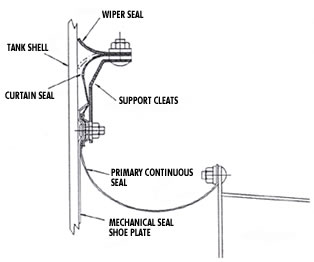|
Secondary
Seals
Understanding
of the loss mechanisms which apply to even well designed, installed
and maintained primary seals led to the development of secondary
seals.
The main objective of secondary seals was to reduce the loss of
stored product from the primary seal area and two main types emerged:-
i) Those attached
to the primary seal.
ii) Those entirely separate from the primary seal.
There is no
doubt that the second category offers the better protection and
reference to the sketches noted will illustrate the difference between
the two categories. Fig. 4 shows a small wiper seal mounted on top
of the shoe plate of an MN1 (mechanical primary seal). This is a
category i) seal and, while it prevents wind-scouring vapour losses
from the primary seal, it gives no protection if the MN1 continuous
seal material should become damaged. Fig.5 is also a category i)
seal but its secondary continuous seal material connects the wiper
seal to the floating roof pontoon and does give some protection
against a perforated primary continuous seal.
Both
seals in Figs. 4 and 5 would become ineffective if there was a gross
failure of the metal shoe plates in the primary seal. If say a pantagraph
or bazooka failure occurs then the shoe plate can move away from
the tank shell, taking the secondary seal wiper with it and permitting
vapour leakage from the resulting gap.

Fig. 4 |
Fig. 5 |
Fig. 6 shows
a category ii) seal where the secondary seal is completely independent
of the primary seal and continues to function even where gross failure
of the primary seal has occurred. The example shown has a metal
compression plate (similar to early windshields but with each leaf
joined and sealed to its neighbours). This gives additional protection
to the primary continuous seal from falling debris etc. and therefore
is clearly preferable to category i) seals.
Variations
of the category ii) seals are:-
Fig. 7 similar
to Fig. 6 but with a suspended vapour barrier of polyurethane connecting
the wiper seal to the floating roof instead of using sealed joints
in the metal compression plates. This is likely to be more expensive
than the sealed plate type and the polyurethane membrane may be
adversely affected by water vapour.
It should be
noted that fitting a secondary seal to a tank could involve slight
loss of useable liquid space since it projects above the primary
seal. This is only true of course if the tank does not have a windskirt
at the top of the shell and if the secondary seal must be kept below
the highest level of the tank shell. The Motherwell Nayler Petroseals
secondary seal (Fig. 8), can be taken beyond the top of the tank
shell without damage to the seal system, provided prior notice is
given. Of course, the full benefits of the secondary seal will not
be available at those times when the seal is above the shell top.
|



